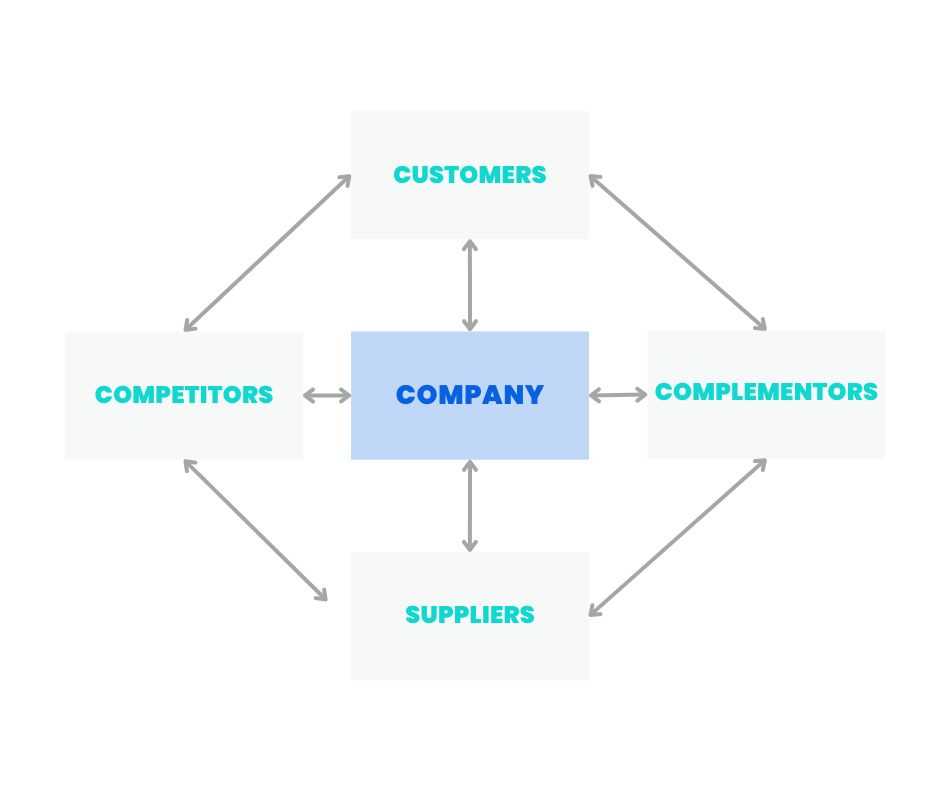What is coopetition? Turning competitors into assets
- Publication date
- Author
- Imogen Beech
- Reading time
- 9 minute read
Coopetition is exactly what it sounds like – a blend between competition and cooperation. In other words, it’s when you collaborate with your competitors.
If you’re thinking: ‘Huh? How the hell do you expect me to make friends with the enemy?’ then hear us out.
Here, we’ll break down exactly what coopetition is. Plus, we’ll look at the risks and rewards, and give you some tips for doing it well. That way, you can work out whether this scary-sounding type of strategic partnership is for you (hint: we bet it will be if you give it a chance!).
Oh, and if you want some real-life examples of companies that are corroborating with the enemy (ahem cooperating with the competition!), head over to our selection of excellent coopetition examples.
Coopetition is the act of cooperating with a competitor. If you’re in coopetition with another business, it means that you’re collaborating with them and competing with them at the same time.
For example, you might collaborate with a competitor on research and development, marketing or distribution while continuing to compete for customers.
That might sound like rocky territory, but the idea behind coopetition is that there can be more than one winner. Instead of working fiercely against your competition to take them down, you can work together to maximise opportunities for you both.
In this way, you both gain a bigger share of the market and increase your profitability. You also increase your competitive advantage against other rivals. Winning!
In 1996, two business professors (Adam M Brandenburger and Barry J Nalebuff) laid out the principles and practices behind coopetiton in their book titled (you guessed it!) Co-opetition.
As part of this, they developed the coopetition model. It helps you to decide whether or not to cooperate with another business, using insights from game theory (a theoretical framework that’s meant to help you predict decisions made by competing players).
The basis of this model is a diagram called the Value Net.

As you can see, the diagram encourages you to place your business at the centre, and the other players in the ‘game’ around the outside. These are your customers, suppliers, competitors and complementors (complementors are competitors who have products that can add value to your business).
All the entities included in the diagram are seen as opportunities for your company – including your competitors!
Through coopetition, the aim is to move from a ‘zero-sum’ game where one winner takes all, to a ‘plus-sum’ game, where the end result makes everyone more profitable.
Let’s go right back to fractions at primary school and think of the market like a cake. Instead of fighting for the biggest slice, the coopetition model thinks you should be focusing on growing the cake. After all, wouldn’t you rather get a 25% share of a $20 billion market than a 70% share of a $5 billion market?!
We’ve already touched on a few of the many benefits of coopetition. However, here are the main rewards you can expect to reap from cosying up with the enemy (by which we mean, competition!)
Like any good thing in life, coopetition has its downsides. So, you’ll need to weigh up the risks as well as the rewards. Here are the main sticking points.
Now that you know the pros and cons of cooperation, you’ll need to look at your individual situation to understand whether the risks outweigh the rewards or vice versa. To help, here are some questions to ask yourself.
Obviously, you don’t have a crystal ball, but it’s worth bearing in mind that doing nothing can sometimes be just as risky as deciding to cooperate.
Let’s say, for instance, that a competitor has approached you suggesting a collaboration. And let’s say that it’s not something you’re particularly interested in.
Now imagine that you say no and they approach another rival of yours with the same offer. Where would that leave you?
It might be that the risks of cooperating still outweigh the benefits. Or it might be that the possibility of your biggest competitors teaming up against you is the greatest risk of all!
In business, your secret sauce is your competitive advantage and what makes you you. Giving away the recipe to your competitor could be problematic. If they can replicate it, why should a customer choose you over them?
With that in mind, this is something that should be heavily guarded – especially if your competitor wants your secret sauce but is refusing to give away their own.
On the other hand, imagine if you and your competitor both agreed to share your secret sauce. Together, you’d be unstoppable!
In an ideal world, you’d find a way to bring your secret sauce to the table without giving away the recipe – that way, you can get the most out of a collaboration with your competitor, while still maintaining tight control over the element of your business that gives you your oomph.
You might think that if you stand to gain more than your competitor, that’s a good thing. After all, if you’re both competing for customers, you want to be the one who comes out on top.
However, that couldn’t be further from the truth. Rather, in an ideal world, you want to make sure that you both stand to gain (or lose) the same amount.
By ensuring that you both stand to benefit equally from your collaboration, you’ll be able to ensure that you both remain invested in the partnership, which is key to making sure it’s profitable and long-lasting. Not only that, but how are you ever going to foster a sense of trust if you’re constantly trying to one-up each other?
Of course, being able to gain equally isn’t always possible, especially when coopetition involves multiple partners or competitors. In this case, make sure that the way you each benefit is fair, given the investment you’ve each made in terms of finances, resources, expertise and time.
Sometimes, your decision of whether or not to cooperate with a competitor might be based on your ability (or inability) to back out from the deal if things aren’t working out the way you expected.
Of course, new collaborations are always going to be a little rocky while you fine-tune your methods and get used to working together. So, it’s important not to jump ship until you’ve given your partnership some time to prove its worth. Interestingly, McKinsey found that a whopping 25% of joint ventures don’t meet or exceed anyone’s expectations, but still benefit all the companies involved!
However, it’s also important to make sure that you have a way of pulling out if it ends up being necessary. Always set out the duration of your partnership in a written agreement, and detail the scenarios in which your partnership could end early, along with appropriate notice periods.
That way, you’re reducing your level of risk and can throw yourself into cooperation wholeheartedly, knowing that you’re protected in some way if things go wrong.
We’ve already touched upon risks versus rewards, but we think they deserve another mention.
Not every cooperation opportunity is going to be perfect. You might find that a deal won’t give you the benefits you’re after, or that your partner won’t agree to the break clause that you want inserted into your agreement.
While your instinct might be to put your walls up and refuse to collaborate, it’s vital that you look at the deal being offered and carefully consider the pros and cons.
Yes, there might be more risks than you’re comfortable with – but you might just find that the risks of not collaborating are greater. Or, that you could benefit from a collaboration in new, unexpected ways. What we’re trying to say is don’t let your preconceptions cloud your judgment!

Crafting a partnership agreement is always important when you embark on a new collaboration. But it’s particularly hard when your partner is also a competitor!
Here are some tips for making sure you nail your agreement and start your cooperation off on the right foot.
First things first, make sure that you lay out in detail all the boundaries of your relationship.
How far will your cooperation extend? Who are the main stakeholders? Which company is responsible for what?
It’s also important to lay out whether one party has more control or whether you both have an equal say over how things are run.
You should confirm in your agreement what the rewards will be for each company – making sure, of course, that they’re equal (or at least fair).
This can be hard when there are several companies involved in a cooperation agreement, especially if they’re different sizes and contributing differently.
Finding a solution that takes into account the contributions made by each company and that feels fair to all the parties involved is crucial. By laying it out in writing, you can ensure that everyone is on the same page and onboard with what’s been agreed (so no excuses for disagreements or companies not pulling their weight later down the line!).
As we’ve already mentioned, it’s a must to include the duration of your collaboration in your agreement.
Consider what happens if someone changes their mind – for instance, how will you wrap up the activities you’ve started? And who gets to keep any joint assets?
As well as putting in place a notice period and process, consider what happens if everything is going swimmingly and both parties are happy. For instance, how can the agreement be extended?
Now that you’re all clued up on the wonderful world of coopetition, all that remains is for us to share a few final tips and tricks for getting the best out of this amazing B2B partnership type.
At the end of the day, coopetition is all about realising that you winning doesn’t necessarily depend on your competitor losing. If you play your cards right, by working together, you could both win much bigger than you could alone.
If you’re ready to reap the benefits of forming partnerships with your competitors, why not book a demo for Breezy? Our partnership intelligence and discovery platform will help you to understand the partner ecosystem you’re operating in, and find you thousands of relevant partner suggestions – whether that’s affiliate, B2B or cooperation opportunities!
Imogen is a copywriter and content writer with over two years’ experience writing about the exciting world of strategic partnerships, as well as running her own business. She loves learning about new topics as she writes, and has enjoyed penning articles on industries ranging from mortgages to events, theatre to home improvements and everything in between.
View more by Imogen Beech